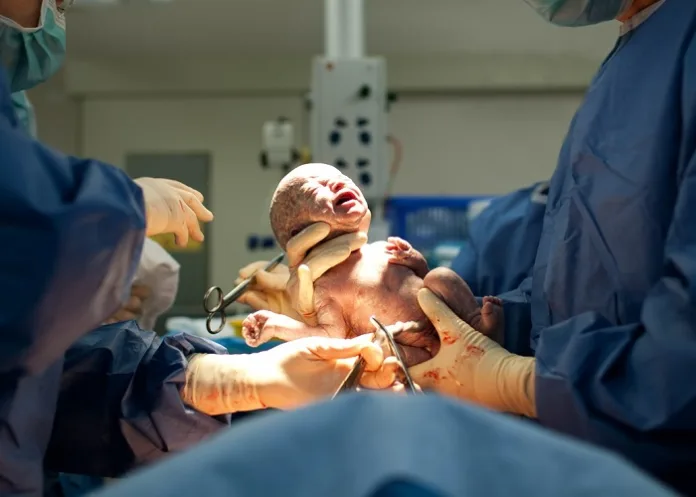In a documented first, four women giving birth by Caesarean section at a London hospital had surgery – at the same time – to cut their risk of ovarian cancer.
The two-in-one operations went well, the doctors told BBC News.
Experts say it is not a decision to be taken lightly, as removing the ovaries puts a woman into early menopause.
Operating at the time of Caesarean delivery also risks greater blood loss, due to the physical changes that occur during pregnancy.
However, it can avoid an anxious wait for the standard cancer risk-reducing operation to remove the fallopian tubes and ovaries, which is usually a standalone procedure.
Professor Adam Rosenthal, who performed the procedure at University College London Hospital, said this type of simultaneous surgery has not previously been reported in a medical journal.
The results are published in Obstetrics and Gynaecology journal.
Claire Lee from London was one of the four women to have the pioneering dual procedure, which took surgeons about an hour to complete.
She was awake for the entire operation, but had a spinal anaesthetic, so felt no pain.
Her operation, when she had just turned 41, was at the same time as the birth of her second child.
Rosenthal said: “We lift the top of the uterus out of the abdomen to bring the tubes and ovaries out of the abdominal incision so they are easily accessible.
“The only real issue is that the blood vessels get much bigger in pregnancy so extra care has to be taken to avoid damaging them. We ligate or cauterise them very carefully.”
No regrets
Lee said she knew she was at higher risk of ovarian cancer due to a gene she had inherited, and wanted to have the risk-reducing surgery as soon as possible after giving birth for the second time.
She has no regrets about the surgery. “It saved me having to go into surgery twice…and the worry; this cloud of fear that I would get ovarian cancer.”
“It’s probably the best decision I’ve made, simply because I didn’t have to take out more time away from my children to go in for another procedure.”
A woman who inherits a BRCA1 or BRCA2 gene variant has an increased risk of developing breast and ovarian cancer during her lifetime.
It is not inevitable that she will get cancer, but her odds are higher than average.
For example:
• Of 100 women in the general population, two will develop ovarian cancer before the age of 80
• Of 100 women with a BRCA2 variant, 11 to 25 will get ovarian cancer by 80
• With a BRCA1 variant, 36 to 53 in every 100 will get ovarian cancer by 80
Study details
Combined Bilateral Salpingo-oophorectomy and Caesarean Delivery in BRCA1/2 Alteration Carriers
Barker, Victoria E; Vlachodimitropoulou, Evangelia; O’Brien, Patrick, Iskaros, Joseph; Rosenthal, Adam N.
Published in Obstetrics & Gynaecology on 2 November 2023
Background
The cumulative lifetime risk of ovarian cancer is 16–68% and 11–30% in female BRCA1 and BRCA2 gene alteration carriers, respectively. Risk-reducing bilateral salpingo-oophorectomy (RRSO) is the only proven way to reduce ovarian cancer mortality. We report a series of patients who underwent risk-reducing surgery at the time of planned obstetric-indicated Caesarean delivery.
Cases
This is a case series of four women carrying a pathogenic germline BRCA1 or BRCA2 gene alteration who underwent RRSO at the time of Caesarean delivery between March 1, 2018, and March 31, 2022. All women were referred during pregnancy to the University College London Hospitals Familial Cancer Clinic for consideration of RRSO at the time of obstetric-indicated Caesarean delivery. Women were considered eligible for RRSO if they had a proven pathogenic germline alteration, would have completed childbearing after the Caesarean delivery, and were older than age 35 or 40 with BRCA1 or BRCA2 alterations, respectively.
Operating time, blood loss, transfusion requirements, length of hospital stay, complications, and ability to breastfeed were assessed and, where possible, compared with the institutional means for similar patients who underwent Caesarean delivery only, to determine whether RRSO was associated with increased morbidity. Women were contacted 11–59 months post-procedure to assess satisfaction. The mean blood loss was 687 mL (range 400–1,000 mL), mean operating time was 68 minutes, mean length of hospital stay was 3 days, and mean change in haemoglobin was −1 g/dL. No patient required a transfusion, had internal organ damage, returned to the operating room, or was readmitted. One of two women with intact breast tissue successfully breastfed, and the other chose to bottle feed. The mean contemporaneous institutional blood loss for Caesarean delivery was not significantly different at 681 mL for singleton pregnancies and 872 mL for twin pregnancies. All four women reported a high level of satisfaction with the combined procedure.
Conclusion
Our results show that RRSO can be performed at the time of Caesarean delivery with high patient satisfaction. This approach can be offered to appropriately counselled individuals, with the benefit of avoiding the need for two separate procedures, with potentially reduced patient morbidity and health care costs.
BBC article – Pioneering operation combines cancer surgery and Caesarean (Open access)
See more from MedicalBrief archives:
Genetic risk scores a poor measure to predict disease – UK study
Prevent ovarian cancer by removing fallopian tubes, urge experts
Swedish study changes guidelines for genetic breast cancer tests

